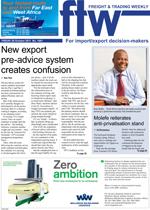The lack of capacity at the
Port of Durban has led to a
significant reduction in the
transhipment of containers
through the port, heavily
affecting the feeder business
in southern Africa.
So much so that Ocean
Africa Container Lines
(OACL) in November
suspended its two-vessel
feeder service between
Durban and Mozambique
as it was just no longer
economically viable.
According to Andrew
Thomas, CEO of OACL,
which operates a fleet of
modern, purpose-built
container ships catering to
regional, feeder and domestic
cargoes, the lack
of capacity in Durban has
significantly reduced the
feeder business.
“It has been very
challenging, as shipping lines
have actively been looking
for alternative hub ports
instead of using Durban. The
result is that discretionary
cargo is moving away
from southern Africa and
transhipment cargo intended
to serve the region has found
alternative hubs.”
He said while there
was much enthusiasm and
hope some 18 months ago
when Transnet launched its
Quantum Leap programme
that was intended to increase
productivity by 30%, not
much has resulted.
“Of course Transnet has
been looking at development
plans to increase capacity
in Durban, but so far the
process has not been very
successful and we have not
seen any increase in capacity.
So while the market has
continued to grow after the
decline we saw in 2009, we
have not benefited due to
Durban’s congestion issues.”
The result, he said, was
that the shipping lines had
not only found alternatives,
but were actively looking
for ways to move containers
away from Durban until the
port could develop sufficient
capacity.
For Thomas it is not just
about developing capacity
but also about ensuring
efficiency. “There are two
components to a successful
port and the first is the
pricing. It has to be pricecompetitive
as part of
a network that provides
effective waterside and
landside connectivity to its
markets.”
The second, he said, and
highly related to the first
component, is that it needs to
be efficient.
“Hub ports that can
consistently provide berthing
on arrival and efficient
service alongside will be
more successful. Durban,
no doubt, has the ability to
do this and has great natural
advantages to help it along –
like its location – but it must
have the capacity within the
port and its landside network
to allow cargo to move
through it efficiently at a
competitive rate.”
Thomas said due to
shipping lines moving their
transhipment business
away from Durban it has
resulted in OACL having to
be innovative in protecting
its commercial business by
utilising alternative facilities
and routes.
Durban inefficiency pushes transhipment cargo to other hub ports
28 Oct 2011 - by Liesl Venter
0 Comments
FTW - 28 Oct 11

28 Oct 2011
28 Oct 2011
28 Oct 2011
28 Oct 2011
28 Oct 2011
28 Oct 2011
28 Oct 2011
28 Oct 2011
28 Oct 2011
28 Oct 2011
Border Beat
Featured Jobs
New
New
